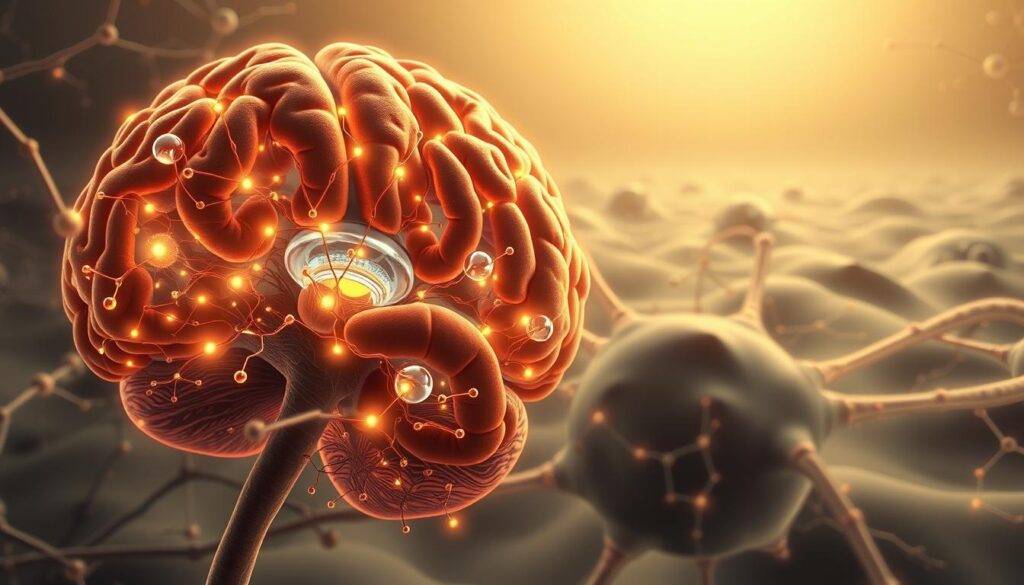Sarah, a marketing manager in Chicago, used to start her day with 47 browser tabs open. Emails pinged nonstop. Slack notifications hijacked her focus. By noon, she’d feel drained—yet barely scratched her to-do list. Sound familiar? Her story isn’t unique. Modern professionals face a paradox: more tools for efficiency, yet less control over their mental bandwidth.
This is where cognitive science reshapes the game. Experts like Cal Newport champion “deep work”—the ability to focus without distraction on complex tasks. But achieving this requires more than willpower. It demands understanding how our brains respond to today’s hyperconnected world.
Three chemical messengers hold surprising power over performance. Acetylcholine sharpens attention during learning. Dopamine fuels motivation when tackling milestones. Norepinephrine kicks in during deadline pressure. Like conductors of an orchestra, these neuromodulators determine whether we fumble through tasks or execute with precision.
The key isn’t logging extra hours—it’s aligning work patterns with neural rhythms. A 2023 study revealed workers lose 2.1 hours daily to app-switching. By redesigning workflows using brain-aware strategies, many professionals reclaim 18+ productive hours weekly. Imagine what you could achieve with that time.
Key Takeaways
- Brain science reveals why traditional time management often fails
- Deep work requires shielding focus from digital interruptions
- Daily distractions cost professionals 500+ hours annually
- Neuromodulators chemically influence focus and motivation
- Peak performance stems from working with your brain’s biology
Understanding Productivity Neuroscience
The modern workplace isn’t just about managing time—it’s about managing brain chemistry. A growing field called productivity neuroscience examines how neural processes shape our ability to concentrate, prioritize, and execute tasks effectively.

What Shapes Cognitive Performance?
Three neurochemicals act as conductors of mental energy. Acetylcholine strengthens connections when learning new skills. Dopamine surges when completing milestones, creating a natural reward loop. Norepinephrine sharpens alertness during challenging work.
Digital distractions disrupt this delicate balance. Constant notifications trigger dopamine-driven curiosity, pulling attention away from priority tasks. “Every ping is like a slot machine lever for your brain,” notes a Stanford behavioral researcher.
Chemical Architects of Focus
Conscious attention operates like a spotlight—bright but narrow. Unconscious processing handles background tasks, like muscle memory for routine actions. Deep work thrives when both systems align through intentional practice.
A 2023 Journal of Cognitive Enhancement study found workers using brain-aware strategies reduced task-switching by 37%. They achieved this by scheduling high-focus work during peak norepinephrine levels—typically mornings for most people.
Understanding these mechanisms helps design workflows that feel less like battles and more like synchronized dances with your biology.
Deep Work and Cognitive Function
Picture a chess grandmaster analyzing 20 moves ahead—their brain filtering out every irrelevant sight and sound. This intense mental state, called deep work, isn’t just for elite strategists. Cognitive science reveals it’s a trainable skill that rewires neural pathways for superior performance.

The Science Behind Deep Work
When fully immersed in complex tasks, the brain enters a hyperconnected state. Gamma waves synchronize across multiple regions—prefrontal cortex for planning, temporal lobe for memory recall, and parietal lobe for spatial reasoning. A 2021 MIT study found this synchronization boosts information retention by 63% compared to fragmented work.
Neurotransmitters act as gatekeepers. Acetylcholine enhances signal clarity between neurons during learning phases. Dopamine maintains engagement through micro-rewards for progress. Cortisol levels must stay balanced—too much stress shuts down creative thinking, while too little reduces urgency.
Mechanisms of Cognitive Concentration
The brain toggles between two modes: task-positive network (focused work) and default mode network (background processing). High performers intentionally activate the former through specific rituals like timed work blocks or sensory-limiting environments.
Research from UC Berkeley shows it takes 23 minutes to regain deep focus after interruptions. Media professionals combat this by:
- Scheduling creative work during biological peak hours
- Using app blockers during 90-minute focus sprints
- Practicing “attention stretching” through gradual increases in undisturbed work periods
A 2022 study tracked writers using these methods—they produced 42% more publishable content in 30% less time. Their secret? Working with the brain’s natural rhythms rather than against them.
Practical Strategies for a Distraction-Free Workplace
Distractions are the silent thieves of attention—but reclaiming mental clarity starts with intentional design. The right strategies transform chaotic environments into focused workspaces. Below are science-backed methods to strengthen concentration muscles and filter digital noise.

Embracing Boredom to Enhance Focus
Resisting the urge to check devices during idle moments builds cognitive endurance. Start small: wait 5 minutes before reaching for your phone during breaks. This trains the brain to tolerate discomfort, strengthening focus over time.
Background soundscapes prove surprisingly effective. Video game soundtracks—designed to keep players engaged without distraction—boost concentration in 68% of users according to a 2023 Sound & Cognition study. Try these options:
| Sound Type | Focus Benefit | Best For |
|---|---|---|
| Ambient Nature | Reduces stress | Creative tasks |
| Binaural Beats | Enhances alertness | Analytical work |
| Instrumental Music | Blocks chatter | Writing/editing |
Choosing Tools and Methods to Limit Distractions
Not all productivity apps serve equal purposes. Match tools to specific goals:
- Time-blocking software for visual schedulers
- Distraction-free text editors for writers
- Focus timers using the 90/20 rule (work/break ratio)
Schedule deep work during biological peak hours—usually mornings for most people. Protect these sessions with app blockers and auto-responders. As Cal Newport advises: “Treat uninterrupted focus time like critical meetings—non-negotiable and recurring.”
Leveraging Lifestyle Factors to Enhance Brain Productivity
Your morning routine holds more power than you might realize. Small daily choices—from bedtime habits to lunch ingredients—directly shape cognitive sharpness throughout the workday. Research shows lifestyle adjustments can boost mental stamina as effectively as advanced time-management tactics.
The Impact of Sleep, Diet, and Exercise
During sleep, the brain replays the day’s experiences—strengthening neural connections. A Harvard study found workers who slept 7-9 hours solved complex problems 31% faster than sleep-deprived peers. Prioritizing rest isn’t laziness—it’s strategic memory consolidation.
Food choices act as cognitive fuel. Omega-3 rich diets improve learning agility, while antioxidants protect neural pathways. Pair this with 150 minutes of weekly exercise—it increases blood flow to the brain by 15%, as noted in recent workplace performance studies.
| Lifestyle Factor | Brain Benefit | Implementation Tip |
|---|---|---|
| Sleep Quality | Enhances problem-solving | Use blue-light filters after 8 PM |
| Balanced Diet | Boosts focus duration | Add walnuts & blueberries to snacks |
| Nature Exposure | Reduces mental fatigue | Place plants near workstations |
Adding greenery to your workplace offers measurable benefits. Office plants increase attention spans by 20%, according to cognitive restoration research. Even viewing nature scenes through windows lowers stress hormones by 15%.
Start with one change this week. Swap afternoon soda for green tea. Take walking meetings. These tweaks compound over time—transforming both health outcomes and professional results.
Implementing Neuroproductive Techniques in Daily Tasks
What if your daily planner could double as a brain chemistry lab? Modern research reveals that strategic task design—not just time management—holds the key to sustained mental performance. By aligning schedules with neural reward systems, professionals gain unprecedented control over their cognitive output.
Balancing Rewards and Pressure in Your Schedule
The brain thrives on balanced challenges. Too much pressure triggers stress hormones. Too little creates complacency. Successful task design uses micro-rewards to maintain dopamine levels while setting clear deadlines to activate healthy norepinephrine responses.
| Approach | Brain Response | Implementation Tip |
|---|---|---|
| Reward-Based Scheduling | Dopamine release after small wins | Pair tedious tasks with enjoyable breaks |
| Pressure Tactics | Norepinephrine surge for urgency | Set public accountability for key projects |
| Balanced Systems | Steady motivation without burnout | Use time-blocking with flexible buffers |
Getting into the Flow with Practical Adjustments
Flow states occur when challenge levels match skill levels. Start sessions with pre-commitment rituals—like organizing tools or silencing devices. These actions signal the brain to enter focused mode.
Try these evidence-backed adjustments:
- Schedule creative work during peak alertness periods (usually 2-4 hours after waking)
- Use 25-minute focus bursts followed by 5-minute movement breaks
- Track progress visually to activate the brain’s reward pathways
Review your routines weekly. Adjust task sequences based on energy patterns. As one behavioral researcher notes: “Optimal performance isn’t about perfect plans—it’s about responsive systems.” Experiment with different combinations to discover your unique cognitive rhythm.
Conclusion
Your brain isn’t just an organ—it’s the ultimate efficiency tool. By aligning daily habits with its chemical rhythms, you unlock hidden potential. Studies show simple changes—like protecting focus time or strategic task sequencing—can reclaim 18+ hours weekly. That’s an extra workday without burning out.
Science reveals two game-changers. First: deep focus strengthens neural pathways like exercise builds muscle. Second: dopamine-driven motivation thrives on clear milestones. Pair these insights with morning deep work blocks and afternoon collaborative tasks for maximum impact.
Start small. Track your energy peaks for one week. Swap multitasking for 25-minute sprints. Notice how intentional pauses between tasks boost retention. As research confirms, quality beats quantity when shaping effective routines.
The future of work belongs to those who partner with their biology. Will you keep fighting distractions—or redesign your day using your brain’s built-in blueprint? Your next breakthrough awaits.
FAQ
How does understanding brain chemistry improve work efficiency?
Brain chemicals like dopamine and norepinephrine regulate attention and motivation. By aligning tasks with natural neurotransmitter cycles—like tackling complex work during peak dopamine hours—you can optimize mental performance without burnout.
Can “deep work” actually change how the brain functions?
Yes. Extended focus periods strengthen neural pathways related to concentration, much like muscle memory. Studies show regular deep work sessions increase gray matter density in regions linked to problem-solving and emotional regulation.
Why is boredom important for maintaining focus?
Allowing moments of boredom resets the brain’s novelty-seeking mechanisms. This reduces dependency on constant stimulation, making it easier to sustain attention during demanding tasks. Think of it as cognitive recovery time.
What lifestyle factors most directly impact cognitive performance?
Sleep quality directly affects memory consolidation, while aerobic exercise boosts BDNF (brain-derived neurotrophic factor), enhancing learning capacity. Balanced blood sugar from protein-rich diets also stabilizes energy levels for sustained mental effort.
How do rewards and deadlines influence motivation neurologically?
Short-term rewards trigger dopamine release, creating positive task associations. Meanwhile, moderate pressure increases noradrenaline, sharpening alertness. The key is balancing both to avoid anxiety while maintaining engagement.
What’s the fastest way to enter a flow state during work?
Start with 10-minute “warm-up” sessions using noise-canceling headphones and task-specific playlists. Eliminate visual clutter on your desk, and set micro-goals to create immediate feedback loops—critical triggers for flow according to Csikszentmihalyi’s research.




























































